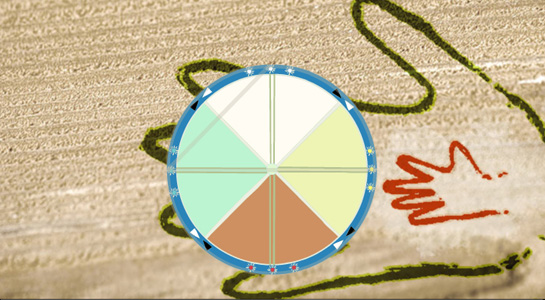CREE (NEHIYAWAK) TEACHING
ELDER: MARY LEE
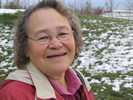
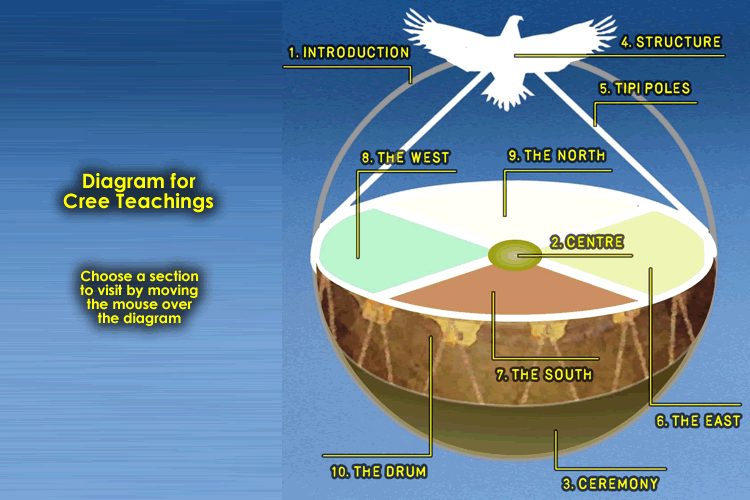
INTRODUCTION (audio narration)
As Cree people, we were given the gift of being named for the four parts of human beings. Nehiyawak, we were called.
It means being balanced in the four parts that are found in the four directions of the Medicine Wheel. These four parts for human beings are the spiritual, physical, emotional and mental aspects of the self. We need to try and balance these four parts that were given to us, to function as people.
The fire is in the centre of the Medicine Wheel. That is where the meaning of the teachings comes from. For me this fire is also the self. When you look at the Medicine Wheel, you start from self. And as you look out, you make your circle.
This is how the Medicine Wheel represents the life journey of people.
The old people will tell you it is life itself. Look at the four seasons and follow the sun. Spring in the east, summer in the south, fall in the west and winter in the north. It tells the whole story of how all life came into being abundantly bright, rising in the east and then fading away as it moves west and north. All life rises and sets like the sun.
What we do in between is our journey. This is where the gifts of the four directions are needed - the gifts of the spirit, physical body, emotions and mind - and where we need to find balance within these four realms. Today, many people are out of balance because they tend to only favour two realms of self, the mental and the physical. They forget to look after their spiritual side, and often don’t know how to express and deal with their emotions.
People think that by showing anger they are expressing their emotions. But that is not what it means to be emotional. Anger is a defense mechanism that protects the emotional part of us. The sensitive part of us is our emotional realm, the part that feels the truth about what’s around us. But we’ll show anger before we’ll show that true part of ourselves because we have learned to be embarrassed by it. We’ll get angry because that’s accepted. Sadly, some people even think it is respected. But we won’t show our true emotions, our vulnerability and sensitivity, because that is not accepted. So we have learned to replace those things with anger.
As for the spirit, there never seems to be enough time. People think you have to make a commitment of time through long periods of devotion to be spiritual. But being spiritual is remembering. It is remembering that the first thing that was gifted to you when you came into being was the spirit. Sadly, we tend to forget that and then we neglect our spirit and take it for granted. So we need to remember where we came from and the gifts that were given to us as human beings.
This way of being in the world was taught to me by my mother through the teachings of making a tipi. The tipi teachings, as I call them today, relate to nurturing the four aspects of the self, the spiritual, physical, emotional and mental, which are rooted in the four directions. The tipi is also a symbol of the women, so in honour of my mother and great grandmother and Cree women everywhere, I will share some of these tipi teachings with you.
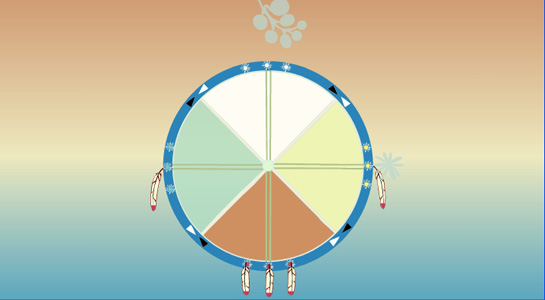
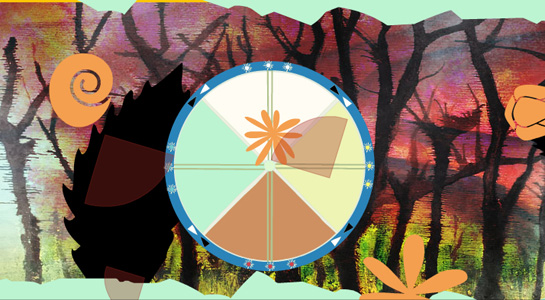
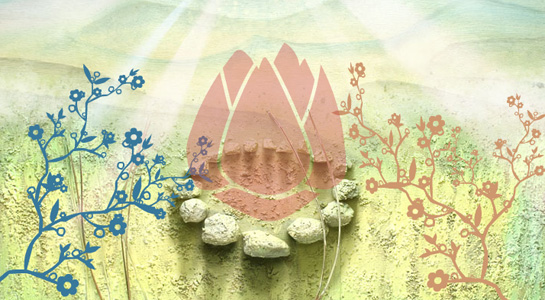
CENTRE (audio narration)
The tipi teachings are passed on. When I talk about the teachings, it’s not to alter or change them; I can only share how it was told to me. There are many, many teachings that belong here with the tipi. I won’t be able to share all of them with you. But in sharing a little bit of the meaning it is hoped that you will continue on your journey to seek the teachings that you require. You’re never done learning.
For us, the word tipi doesn’t mean anything. There is a Cree word we use today; we say migawap. But traditionally, when my mother was teaching me about the tipi, she would say Kitche Migawap.
In the beginning, it didn’t come in the shape of a tipi. It came in the shape of a dome, which we still use today. It’s known as a Sweat Lodge. When that lodge came to us, you couldn’t make a fire in there. The people would gather the rocks outside, heat them up, and then bring them into a pit in the middle. This would keep them warm during the night. But they couldn’t make a fire in there to cook. They had to do all their cooking outside.
So when the lodge became bigger through the structure of the tipi, they could make a fire inside. My mother said that the women were named after that fire in the centre of the tipi, which brought that warmth and comfort. In the Cree language, the centre, the fire, is iskwuptew. “Woman” in our language is iskwew, more than one woman, iskwewuk. We were named after that fire, iskwuptew, and that is very powerful, because it honours the sacredness of that fire.
In our language, for old woman, we say, Notegweu. Years ago we used the term Notaygeu, meaning when an old lady covers herself with a shawl. A tipi cover is like that old woman with a shawl. As it comes around the tipi, it embraces all those teachings, the values of community that the women hold. No matter how many children and great grandchildren come into that circle of hers, she always still has room. And if you put it up right, the poles never show on the bottom, and that tipi stands with dignity, just as, years ago, women always covered their legs with the skirt, which also represents the sacred circle of life. And when you put the flaps up, it teaches you how we embrace life itself. It’s like a woman standing there with her arms out, saying “Thank you” to everything.
That is what the tipi is - it is the spirit and body of woman, because she represents the foundation of family and community. It is through her that we learn the values that bring balance into our lives. That is why, when you construct a tipi, it involves ceremony: because the ceremony of making a tipi represents the value of women’s teachings.
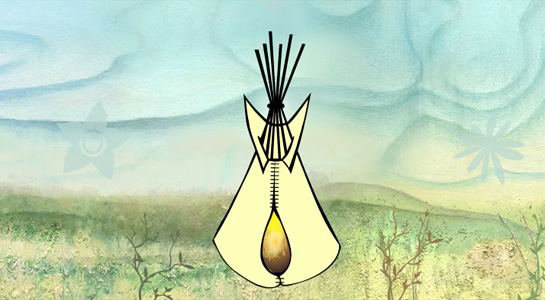
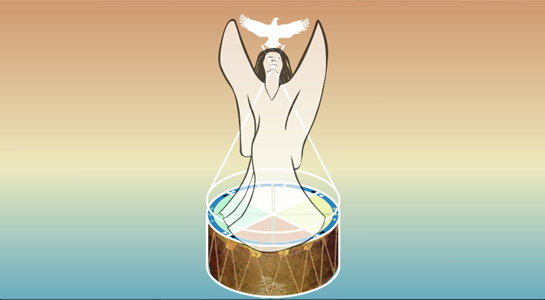
TIPI CEREMONY (audio narration)
When I make something, it’s not just to make it; it’s got meaning to it. It’s like when I pick sweetgrass, and when I braid it, there’s a prayer that goes in there. Whoever I give that sweetgrass to, when they burn it, those prayers come out, and they help that person.
It’s the same with a tipi. When I make a tipi, when it goes up the first time, it has to face the east, because a tipi to me is not just a symbol, it’s a ceremony.
The doorway is very important in ceremony. For ceremonial purposes, the Cree face the doorway east because that represents the beginning of creation.
Today, people forget that. That is why, when I am asked to make a tipi for someone, I take them through the ceremony so that they can embrace the true meaning and teaching of the tipi. I hope that it is a way to touch their spirit and provide guidance for them on their journey.
Before making a tipi, I offer tobacco. I don’t just stand and let that tobacco fall; I sit on the ground with humbleness, because I am offering something for something I will use from Mother Earth. Because it’s not ours; everything we take is borrowed; we’re borrowing time; we’re borrowing all the things we need to make a tipi.
I also ask whoever I am building the tipi with to offer tobacco with humbleness. I usually ask the women in that family to offer the tobacco, because the tipi is a woman’s symbol; and the ceremony is a woman’s teaching. The men can be part of the ceremony and can help to put up a tipi but they can’t hold the teachings, because they are not women. The men need the women to be present during the making of the tipi to take in those teachings and to offer that sacred tobacco to Mother Earth because that is all part of the ceremony.
I learned this through doing it, and through the instruction of my mother, who taught me that tobacco must be given for each stage of the process. So when I go out to the land and cut down the tipi poles, I make offerings of tobacco each time. This is how we honour the resources and gifts of our Mother Earth. She has gifted us for a very long time.
Today, people use tipis more or less for symbolic reasons. But I have made the commitment to share the teachings of the tipi each time I put one up. I do this because the tipi is a ceremony that reminds us of the balance we must bring to our lives and of the powerful teachings that the women have.
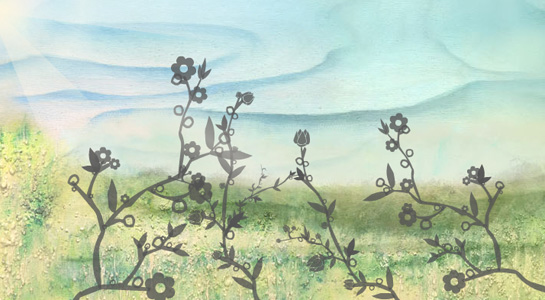
TIPI STRUCTURE (audio narration)
Today I make tipis that stand twenty-two feet high, but years ago, tipis were maybe twelve or thirteen feet. They didn’t have the material for large structures because they used hide instead of canvas and rocks instead of ground pegs. That is why today you can still find circles of rocks, or tipi rings, on the land. It wouldn’t make sense to have your tipi too high, because the winds and storms would catch it.
As time passed, the rocks were replaced with chokecherry ground pegs because they were one of the harder woods once they were dry. Today I cut and peel spruce for the tipi poles and I use sticks to adjust the front flaps of the tipi entryway. My mother used a bone from the moose leg to close the tipi in the front.
My mother never used a measuring tape, or mapped things out mathematically – she just cut out her tipi and made it. And each time it was perfect.
The Cree people use 15 poles to make the structure of the tipi. For every pole in that tipi, there is a teaching. So there are 15 teachings that hold up the tipi. Other Nations use 16 poles, and maybe more, I don’t know. All I know is what I know I was taught and that is the teachings for 15 poles.
The tipi does not have to face east all the time; it can rotate in any direction. It is only the first time that I request that the tipi face east, because of the opening ceremony.
To start, we take three poles and bind them together to make a tripod. Each pole also has a very specific meaning. These three together fortify the structure. They are obedience, respect and humility. Notice the poles, the way they stand. If they stood straight up and down, they couldn’t support a tipi. But balanced properly together, they are able to reinforce each other. There’s a teaching in that. In order to make a family, you need three: the two parents and the child, to make that balance.
The tops of the poles have many teachings. Each one points in a different direction. We are like those poles. We all need the strength and support of our families and communities, but we accept that we all have different journeys and point in different directions.
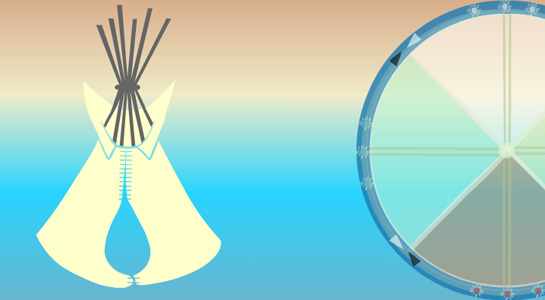
The poles also teach us that no matter what version of the Great Spirit we believe in, we still go to the same Creator from those many directions and belief systems; we just have different journeys to get there. And where the poles come out together at the top, it’s like they’re creating a nest. And they also resemble a bird with its wings up when it comes to land, and that’s another teaching: the spirit coming to land, holding its wings up.
TIPI POLES (audio narration)
We could talk about each of these poles for a long time; each one holds many teachings, and takes a long time and much experience to truly understand. I will give you some words on each pole, to give a beginning idea of what the poles represent.
TIPI POLES
OBEDIENCE
Obedience means accepting guidance and wisdom from outside of ourselves, using our ears before our mouth. We learn by listening to traditional stories, by listening to our parents or guardians, our fellow students and our teachers. We learn by their behaviors and reminders, so that we know what is right and what is wrong.
RESPECT
Respect means giving honor to our Elders and fellow students, to the strangers that come to visit our community, and to all of life. We must honor the basic rights of all others.
HUMILITY
We are not above or below others in the circle of life. We feel humbled when we understand our relationship with Creation. We are so small compared to the majestic expanse of Creation, just a “strand in the web of life.” Understanding this helps us to respect and value life.
HAPPINESS
After the tripod is up, the fourth pole completes your doorway. This fourth pole teaches us happiness. We must show some enthusiasm to encourage others. Our good actions will make our ancestors happy in the next world. This is how we share happiness.
LOVE
If we are to live in harmony we must accept one another as we are, and accept others who are not in our circle. Love means to be good and kind to one another and to our selves.
FAITH
We must learn to believe and trust others, to believe in a power greater than ourselves, whom we worship and who gives us strength to be a worthy member of the human race. To sustain our spirituality, we need to walk it every day. Not just sometimes, but every day. It’s not just once a week; it’s your life.
KINSHIP
Our family is important to us. This includes our parents, brothers and sisters, who love us and give us roots that tie us to the lifeblood of the earth. It also includes extended family: grandparents, aunts, uncles and cousins, and their in-laws and children. They are also our brothers and sisters and give us a sense of belonging to a community.
CLEANLINESS
Today when we talk about cleanliness, most people think hygiene, and that’s very important. But years ago, when old people talked about cleanliness, they meant spiritual cleanliness. When I used to sit with the old Kookums in their tipis, spiritually, they were so powerfully clean. Clean thoughts come from a clean mind and this comes from our spirituality. With a clean mind and sense of peace within we learn not to inflict ills on others. Good health habits also reflect a clean mind.
THANKFULNESS
We learn to give thanks: to always be thankful for the Creator’s bounty, which we are privileged to share with others, and for all the kind things others do for us.
SHARING
We learn to be part of a family and community by helping with the provisions of food and other basic needs. Through the sharing of responsibilities we learn the value of working together and enjoying the fruits of our labor.
STRENGTH
We are not talking about physical strength, but spiritual strength. That was instilled in us when we were young people through fasting. We must learn to be patient in times of trouble and not to complain but to endure and show understanding. We must accept difficulties and tragedies so that we may give others strength to accept their own difficulties and tragedies.
GOOD CHILD REARING
Children are gifts from the Creator. We are responsible for their wellbeing, spiritually, emotionally, physically, and intellectually, since they are blessed with the gift of representing the continuing circle of life, which we perceive to be the Creator’s will.
HOPE
We must look forward to moving toward good things. We need to have a sense that the seeds we are planting will bear fruit for our children, families and communities.
ULTIMATE PROTECTION
This is the ultimate responsibility to achieve the balance and well being of the body, mind, emotions and spirit for the individual, the family, the community and the nation.
CONTROL FLAPS
The control flaps on a tipi teach that we are all connected by relationship and that we depend on each other. Having respect for and understanding this connection creates and controls harmony and balance in the circle of life. When we don’t know how to use the flaps, it gets all smoky inside the tipi, and you can’t see, which is like life – because if we can’t live in balance, we can’t see clearly where we’re going.
CONCLUSION - POLES
For every time that a pole is added, a rope goes around to bind that pole into place. You have to be there and see it to appreciate that teaching. That rope is a sacred bond, binding all the teachings together until they are all connected.
I have shared these teachings with you with the hope that they will help keep the women strong and will help our communities to nurture healthy, balanced people.
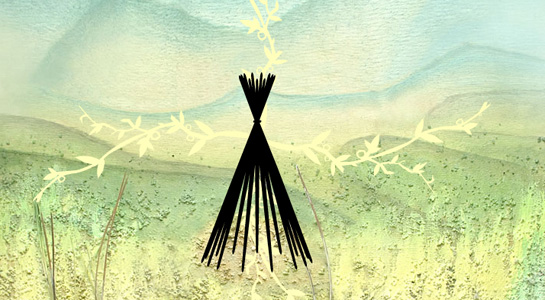
EAST (audio narration)
The woman spirit comes from the east, where the sun rises, where our warmth and vision starts. And the spirit of women brings that warmth into the home.
One of our four sacred medicines, sage, also resides here in the east, because it is women’s medicine. It comes from the buffalo plant that was gifted to the women. It is called prairie buffalo sage. There are many sacred teachings about the plants and medicines, and of how they decided to be where they are, but that is another teaching for another time.
Here in the east is the beginning of all life, when the spirit is conceived and gifted to the womb of the mother-to-be. And because that being is identified as a person at conception, the older women taught us how to balance ourselves during that nine-month journey, how to look after ourselves so that journey would not be disrupted. My mother would sit and talk with the young women, and the men too, about how to make that connection with that spirit, before the child was even born. Because it hears your voice, has your emotions, feels your spiritual state during that nine-month journey. She used to say, “Your child can hear everything you say, feels all your emotions.”
My mother also taught how human life is conditioned in the first year. She called it Eshkawasis, meaning “new child.” She stressed the importance of this first year - that the new chid’s journey in this time should be especially safe. For example, you would always carry your child with two hands, with the greatest respect; you don’t carry such a special gift under one arm.
A newborn is very powerful, the greatest of all teachers. They can sense things that are not the norm, and let you know, protect you spiritually. We call it having a nightmare, but that’s not what it is. And they continue to teach us as they grow. For example, they will crawl, stand, fall down and get up again, and learn to walk. My mother used to say, “That child teaches you what life’s going to be - you don’t just get up once and walk forever - you will fall, and you will have to get up. Maybe you’ll need to crawl a little bit, but you will get up and walk again.”
She said, “look at that child, how they struggle. They teach us that we don’t give up just because we fell. Even as they get older, they fall by playing. Again, that’s a reminder: we must always persist in getting up and doing things again and again.”
My mother also taught us to give thanks to Mother Earth for accepting our child to walk upon her. When that time comes, a celebration feast happens, and Elders come and pray for that young person on the next stages of their journey.
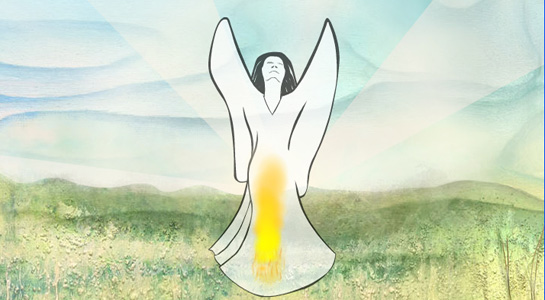
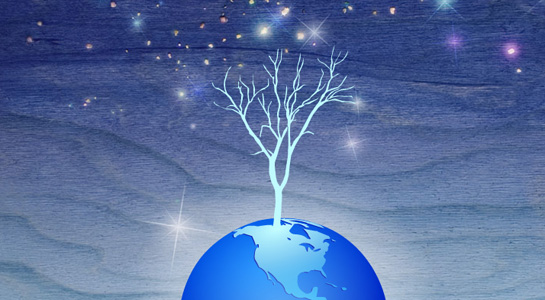
SOUTH (audio narration)
Here in the south all life is active. It’s the time of summer. Our physical aspect is represented here. In this part of our journey, we become young people. The young are very physical beings, very active, continuously moving, changing themselves, even their moods. We have good energy at this time of our journey.
A lot of people today are scared of youth; we don’t quite understand or trust them. But there’s a reason why: we’ve kept them apart from that circle of life. We need to respect youth, and accept them into our world. In our Cree language, there’s no word for “teenagers.” They’re young adults. And we need to encourage youth. We don’t need to say, “You’re bad,” because there are no bad people; we only do bad things.
But sometimes youth need to be reminded by the old people. And that’s okay. I notice older people saying, “I can’t tell my grandchildren that, because they don’t believe me, they don’t listen; they think I’m wrong.” Say it anyway. Like my mother used to say, “You don’t hear everything today, but someday you will hear what’s been said. When you need it you will hear it.” So it’s good to take young people to older people, to have them sit there and listen. Because they might be blocking out that day, but their spirit never blocks out; their spirit will take in the information.
And we should take the youth to see different people. My mother used to say, “If you only go to one elder all your life, you will only know what that one elder knows.” So expand your wings and learn. Go and listen. You might not agree, but hear how that person is teaching. Hear the teachings from other nations, and remember yours. But don’t ever contradict or correct them. Only when you’re asked do you share. Young people sometimes disrespect the Elders when they’re talking about stories and teachings; they’re correcting them. But that Elder can only share with you what they’ve heard and what they remember. Maybe you heard it different, but that’s okay. If you listen, you’ll be richer, because now you’ve heard different sides of the story.
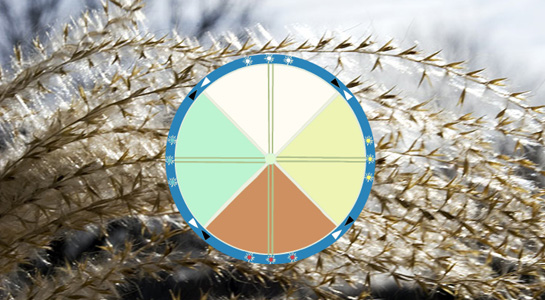
WEST (audio narration)
Here in the West is the time of adulthood, of responsibility. You’re responsible at that time for other people. It’s also the parenting stage of your life journey when you have that bond with the child in the eastern direction.
And most often we are so touched by our children that we want them to have a better life than we have as adults.
And those children teach us, help us to remember to go back and do things over and over again even when we fall. It’s never a smooth journey when you are an adult because you have a lot of responsibility. You’re responsible for the children that you brought into this world. And once you’re a parent, you’re a parent for life.
So at that time, thinking about those responsibilities, people tend to seek advice from older people and sometimes the emotions and stories from your childhood experience come out at that time.
That’s why that gift of emotion is also in the West with the adult. We can do our own thinking and speak out more as adults we’re stronger, more capable, if we have grown in a good way. And if we know we need to get healthy, that’s usually when we come out and talk about issues that have held us back in our journeys to be good people, to live a good life.
It’s a time to let go of anger and disclose emotion because a lot of times emotion turns to anger and that’s when it’s no good. It can be very harmful. It’s better if the emotion turns into a release through crying, which is a good way. It is a time when you can process your emotions and no longer be afraid or shy, when you are brave enough to tell your story. If there’s anything we need to get rid of most often that’s when we do it on our adult journey because sometimes we keep our mourning, our loses in family and life until that time when we realize we need to let go if we’re going to have a healthy journey.
And it often takes that long until we are adults to finally grow that way, when we are faced with great responsibility
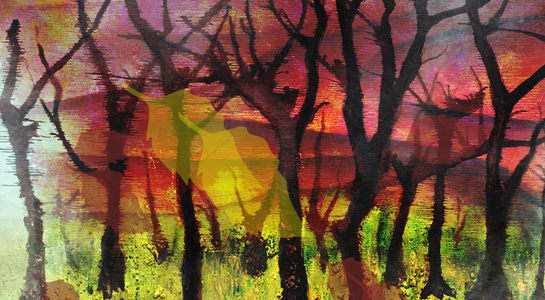
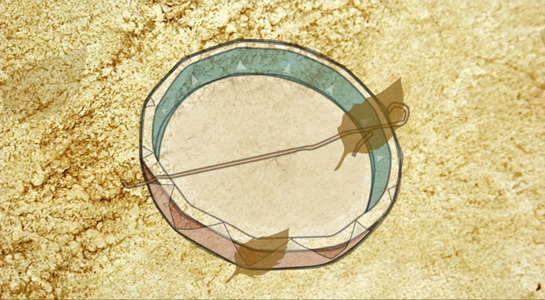
NORTH (audio narration)
We started from the east, we went to the south, and in the emotion part we went to the west in our journey. That’s like any ceremony we go to. We start our ceremonies in the east, and then we’ll finish in the northern direction, which is our life journey. We finish our journeys as older people in that direction - which is the mental part of our journey.
I think the mental part is there because we’re capable then to stop and think, and look at our journeys and foresee the journeys of our people. Because we have the capability to be mentally intact, to know a lot of things that are needed in our communities, in our people. We have time to think; we’re not so rushed, not so physical any more. We went through our emotional stage of life. Now we are sort of the thinking part of the community, of the family. We are the ones that make decisions for families. We’re supposed to be the brain people; if we’ve looked after ourselves, we get to that stage in our journey.
And in this place we also have that relationship with the youth – who are looking to us from the south.
And we’re in that stage for a certain amount of time. Then we go back into infancy. You often see old people starting to forget, starting to act like children. They need help to walk, to be fed. We go back into that spirit world of being an infant one more time. In Aboriginal society that was accepted. When you see old people go into that stage in their journey, beyond their mental capabilities and back into that infancy, spirit, they talk a lot about their childhood, remember it like it happened today, remember those stories so vividly, but they won’t remember much about their adulthood or their youth. They’ll remember, because they’re going back into that journey. My grandmother used to talk about how they played and how they climbed trees. She was 92 years old and she would tell me stories about when she was little, being a child. Because she was going back into being a child one more time.
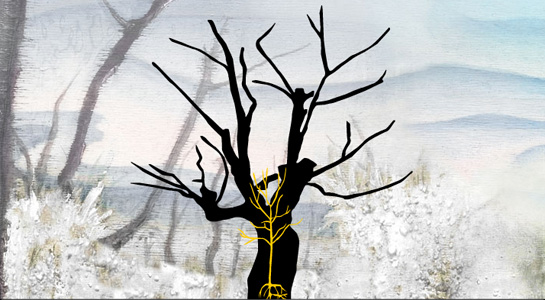
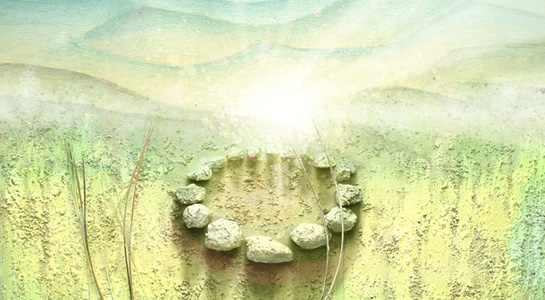
THE DRUM (audio narration)
There’s a teaching in the four directions of the Medicine Wheel about responsibility and relationship between the four stages of life. This teaching comes from the teaching of the drum, the circle that is the drum. When you criss-cross the directions as you tie the drum, it shows how adults can parent an infant because the tie goes from the child to the adult. And from there it goes to the elder who is tied to the youth. That’s why it was gifted at the time of creation of human beings that the adults should parent that infant and that’s why Elders can often speak to young people better than an adult that’s parenting that young person because that connection in the wheel is coming from north to the south, from Elder to youth. It’s so so important today and a lot of times when the young person comes along in the southern door, that’s why then grandparents were used to give teachings at that time. Sometimes grandparents only took that child for a year or two, sometimes longer. The dominant society never understood when a young person was moved to the grandparents. It wasn’t because the parents couldn’t parent, they just knew that cycle of teaching in the four directions. It’s in the Medicine Wheel. Our lives are like the Medicine Wheel – all our motion, our life, our journeys are in the Medicine Wheel. That’s how the teachings happened years ago.
